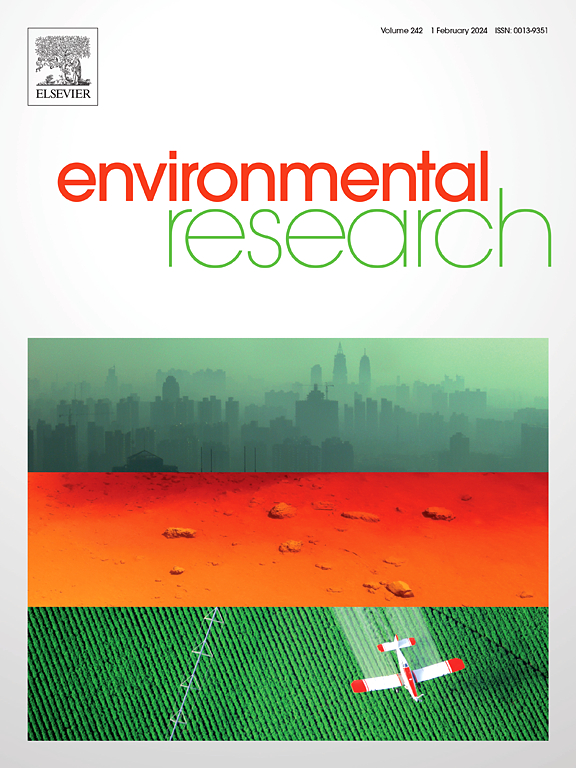Chemical characterization and oxidative potential of persistent organic pollutants (POPs) in size-resolved particulate matter across industrial and traffic stations
IF 7.7
2区 环境科学与生态学
Q1 ENVIRONMENTAL SCIENCES
引用次数: 0
Abstract
This study is the first to investigate polychlorinated dibenzo-p-dioxins and dibenzofurans (PCDD/Fs), polychlorinated biphenyls (PCBs), and polychlorinated naphthalenes (PCNs) across multiple particulate matter (PM) sizes (PM1.0, PM2.5, TSP) in Taiwan, focusing on spatio-seasonal variations, chemical composition, sources, and oxidative potential (OP) utilizing Real-time Cell Analysis (RTCA) and the Dithiothreitol (DTT) assay. PM samples were collected from the Northern Industrial Station (NIS: PM) in Taoyuan, and the Central Industrial (CIS: PM2.5) and Central Traffic (CTS: PM2.5) stations in Taichung (2022–2023). Elevated PCDD/F, PCB, and PCN levels were observed at NIS during winter, with PM2.5 and PM1.0 comprising 90 % and 50 % of TSP, respectively, driven by local emissions and meteorological influences. PCDD/Fs peaked in winter at CTS (7.16 ± 1.64 fg TEQWHO/m3) and in autumn at CIS (8.29 ± 3.21 fg TEQWHO/m3), while PCBs were highest in summer (CIS: 0.151 ± 0.212 fg TEQWHO/m3; CTS: 0.006 ± 0.013 fg TEQWHO/m3), likely due to temperature-driven volatilization. Notably, PCNs exhibited no clear seasonal trends. Cytotoxicity assays revealed a size-dependent toxicity gradient (PM1.0: 71.8 % > PM2.5: 62.1 % > TSP: 51.9 %), with PM2.5 toxicity consistent across sources (P = 0.58). DTT assays indicated higher OP at Northern Taiwan's industrial site on weekdays, whereas Central Taiwan's industrial and traffic sites showed no substantial variation (p > 0.05). Markedly, NO3− strongly correlated with OP across all PM sizes, while Cu and Cr were linked to OPv, and Mn and Cr to OPm. These findings highlight seasonal and source-driven PM toxicity, with smaller particles posing greater health risks, requiring targeted mitigation.

持久性有机污染物(POPs)在工业和交通站点的尺寸分解颗粒物中的化学表征和氧化电位
本研究首次在台湾研究多氯二苯并对二恶英和二苯并呋喃(PCDD/Fs)、多氯联苯(PCBs)和多氯萘(PCNs)在多种颗粒物(PM)尺寸(PM1.0、PM2.5、TSP)上的时空变化、化学成分、来源和氧化电位(OP),利用实时细胞分析(RTCA)和二硫代三糖醇(DTT)测定。在桃园北部工业站(NIS: PM)、台中中央工业站(CIS: PM2.5)和中央交通站(CTS: PM2.5)采集PM2.5样本(2022-2023年)。冬季在NIS观测到PCDD/F、PCB和PCN水平升高,其中PM2.5和PM1.0分别占总悬浮颗粒物的90%和50%,这是由当地排放和气象影响驱动的。PCDD/Fs冬季峰值为CTS(7.16±1.64 fg TEQWHO/m3),秋季峰值为CIS(8.29±3.21 fg TEQWHO/m3),夏季峰值为CIS(0.151±0.212 fg TEQWHO/m3;CTS: 0.006±0.013 fg TEQWHO/m3),可能是由于温度驱动的挥发。值得注意的是,PCNs没有明显的季节趋势。细胞毒性试验显示,PM1.0: 71.8% >;PM2.5: 62.1% >;TSP: 51.9%), PM2.5的毒性在不同来源之间一致(P = 0.58)。DTT分析显示,在工作日,台湾北部工业场所的OP较高,而台湾中部工业和交通场所的OP没有明显变化(p >;0.05)。NO3−与OPv密切相关,而Cu和Cr与OPv相关,Mn和Cr与OPm相关。这些发现强调了季节性和来源驱动的PM毒性,较小的颗粒构成更大的健康风险,需要有针对性的缓解。
本文章由计算机程序翻译,如有差异,请以英文原文为准。
求助全文
约1分钟内获得全文
求助全文
来源期刊

Environmental Research
环境科学-公共卫生、环境卫生与职业卫生
CiteScore
12.60
自引率
8.40%
发文量
2480
审稿时长
4.7 months
期刊介绍:
The Environmental Research journal presents a broad range of interdisciplinary research, focused on addressing worldwide environmental concerns and featuring innovative findings. Our publication strives to explore relevant anthropogenic issues across various environmental sectors, showcasing practical applications in real-life settings.
 求助内容:
求助内容: 应助结果提醒方式:
应助结果提醒方式:


